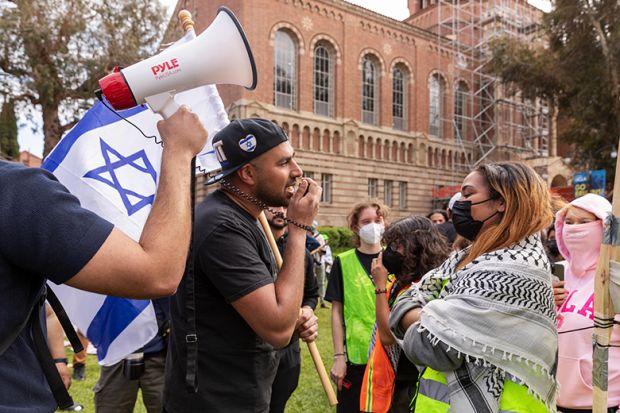Even before the Israel-Gaza war began in October 2023, sparking bitter protest and counter-protest across campuses, it was apparent that student demonstrations in the US had become more frequent and more confrontational than ever before.
When student protesting began in the mid-1960s, the South African anti-apartheid impetus was very important, but the Vietnam War soon became the overriding issue. Students were mostly united in their opposition to university policies that they believed to be pro-war – including some research projects, Reserve Officers’ Training Corps programmes and military recruitment activities on campus.
This substantial unanimity meant that there were few if any incidents when students confronted other students in an adversarial way. There was also a clear sense that if the war were to end, most student protests would also cease.
In addition, most – although not all – universities were then relatively modest in size and sufficiently coherent as institutions to sustain long-lasting presidencies: 10 to 15 years was not unusual, despite the war. The student “clientele”, moreover, was scarcely variegated. At private universities, many students came from expensive boarding schools. There were few black students, and there were often limits on the number of Jews. Coeducation did not arrive at many private institutions until the 1970s. In short, “diversity” was not yet a driving concept in university admissions.
Now, of course, it is. During the 1970s, black students began to be admitted in greater numbers. Then quotas on Jewish students were dropped, and kosher kitchens (as well as Hillel societies) became routine. More Catholic students arrived. Numbers of Hispanic and Asian American students increased. Then the entire spectrum of LGBTQ+ students began to enter openly in the 1980s and 1990s. More foreign students also began to enrol.
In addition, the demands placed on university presidents have multiplied. Each successive incumbent is expected to bring the institution to “new heights”, adding new programmes or institutes or departments and new resources through fundraising. The result has been institutional growth, with additional enterprises and greater decentralisation. Silos have grown up that know little about one another and have their own purposes and motivations to succeed, sometimes with unfortunate institutional consequences. For example, a number of universities had athletic departments in the 2000s whose leaders effectively sold admission to some families whose children were not qualified.
Finally, the study of the humanities – and indeed the “liberal arts and sciences” – began to diminish steadily during and after the 1970s. Student “majors” have become more career-related and “instrumental”. This tendency reflected a change in the university itself: “problem-solving” – in public affairs, climate change, medicine and many other fields – became the hallmark of many institutions, as “Ivory-Towerism” was increasingly shunned. That form of engagement meant that students were more likely to be involved in – and responsive to – controversial world events as they unfolded – and potentially on different sides.
The tensions that these developments created were readily apparent to me during my tenure as Harvard University president through the 1990s. In his 2005 book, Veritas: Harvard College and the American Experience, Andrew Schlesinger describes how “the demands of diversification [were] shaking the foundations” of Harvard at that time, requiring all my “folksy talents and wisdom” to negotiate. For instance, during just one night, 11 November 1991, “stealthy messengers carried copies of the latest edition of Peninsula, the conservative magazine…attesting that homosexuality was un-Christian and undermined society” while “the Bisexual, Gay and Lesbian Students Association held a protest rally, drawing several hundred people”. Meanwhile, “tensions flared when the Black Students Association invited [someone]...to speak on Jewish complicity in the African slave trade [while] about 450 people picketed peacefully outside”.
What was unusual about these episodes, in contrast to the 1960s, was that students were confronting other students in openly hostile ways. Fortunately, there was no violence, but spontaneous protest events of one group against another were a harbinger of things to come.
The protests of 2023-24, of course, saw both aggression towards Jewish students and Islamophobic incidents occurring with a virulence unseen before on our campuses. A detailed examination of incidents at Columbia, Princeton, Stanford, Berkeley, Harvard and elsewhere reveals that a new era has arrived. Indeed, the pressures are such that university presidents now find it increasingly difficult to lead their institutions: their average length of tenure is currently less than six years.
Attempts to gain greater institutional concord without sacrificing the free exchange of ideas must not be abandoned. But success is only likely if individuals and groups can be convinced to care more about realising a measure of institutional unity and common educational purpose in an atmosphere of mutual respect – where a degree of concord is indeed sought and is to some degree actually found.
To achieve this, it will be at least necessary for universities to clarify what is – and what is not – acceptable protest behaviour and for them to be willing to respond with disciplinary action for unacceptable actions. Those are minimal processes. More positive reactions are to be hoped for, such as greater tolerance by students when they confront others with very different views. Together, these actions may achieve a measure of future concord.
Neil Rudenstine was president of Harvard University between 1991 and 2001. His book, Our Contentious Universities, will be published by the American Philosophical Society Press in March.




